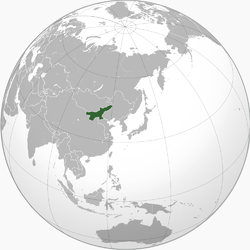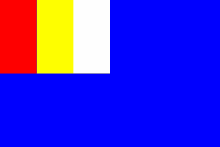- Mengjiang
-
Mengjiang United Autonomous Government
蒙疆聯合自治政府
Měngjiāng Liánhé Zìzhì ZhèngfǔPuppet state of Japan.
After 1940 autonomous region of the Reorganized National Government of China.
← 
1936–1945  →
→
 →
→Flag
Map of Mengjiang Capital Kalgan Language(s) Chinese, Mongolian, Japanese Government Military dictatorship, Republic History - Established 1936 - Disestablished 1945 Mengjiang (Chinese: 蒙疆; pinyin: Měngjiāng; Wade–Giles: Meng-chiang; Postal map spelling: Mengkiang; Hepburn:Mōkyō), also known in English as Mongol Border Land, was an autonomous area in Inner Mongolia, operating under nominal Chinese sovereignty and Japanese control. It consisted of the then-Chinese provinces of Chahar and Suiyuan, corresponding to the central part of modern Inner Mongolia. It is occasionally called Měnggǔguó (蒙古國) or Mengkukuo (in analogy to Manchukuo, another Japanese puppet state in Manchuria). The capital was Kalgan, and the ruler was Demchugdongrub.
Contents
History
Formed on 12 May 1936, the Mongol Military Government (蒙古軍政府) had Prince Yondonwangchug of Ulanqab as its first chairman. It was renamed in October 1937 as the Mongol United Autonomous Government (蒙古聯盟自治政府).[1] On 1 September 1939, the predominantly Han Chinese governments of South Chahar and North Shanxi were merged with the Mongol United Autonomous Government, creating the new Mengjiang United Autonomous Government (蒙疆聯合自治政府).
The capital was established at Chan Pei[citation needed], near Kalgan (Zhangjiakou), with the government's control extending around Hohhot. On 4 August 1941, it was again renamed: the Mongolian Autonomous Federation (蒙古自治邦). After Wang Jingwei formed a new government for the Republic of China in Nanjing, Mengjiang was placed under its control, though it remained completely autonomous.
Mengjiang ceased to exist in 1945 when it was invaded by the Soviet Red Army and Mongol Red Army as part of the Manchurian Strategic Offensive Operation. Most of the area, with the notable exception of Kalgan, is now part of Inner Mongolia in the PRC.
Politics
List of political institutions:
- Mongolian Royal Family
- Japanese Central Academy of Kalgan
- Directorate General of Communications
- Bank of Mengjiang
- Mongolian Military Command Headquarters
- Mengjiang national army
- United Autonomous Mongolian Aimags
- Autonomous Government of Northern Shanxi
- Autonomous Government of Southern Chahar
- The United Autonomous Government of Mengjiang
- Government Mongol administrative uls
- Inner Mongolia Pailingmiao Autonomous Political Council (Mongolian political movement)
Notable people:
- Demchugdongrub: Khungtayji Head of State; Commander of the Mongolian Military Command Headquarters.
- Kanji Tsuneoka: Japanese military advisor, Head of Central Academy of Kalgan, Leader of local Kempeitai
- Toyonori Yamauchi: Political advisor tasked with ensuring that Mengjiang "inherit the great spirit of Genghis Khan and retake the territories that belong to Mongolia, completing the grand task of reviving the prosperity of the nationality".
- Yoshio Kozuki: Commanding General, Mongolia Army
- Ichiro Shichida: Commanding General of the Mongolia Garrison Army
- Gen Sugiyama: Commanding General of the Mongolia Garrison Army
- Sadamu Shimomura: Commander of Mongolia Garrison Army
- Hiroshi Nemoto: Commander of Mongolia Garrison Army
- Shinichi Tanaka: Chief of Staff, Mongolia Garrison Army
- Hideki Tōjō: Commander of the 1st Independent Mixed Brigade, Chahar Expeditionary Force
- Commander Sakai: Tank commander in the 1st Independent Mixed Brigade
- Kitsuju Ayabe: Colonel, engaged in Chahar area operation as Staff Officer, Kwantung Army, North China Detachment
- Hiroshi Nemoto: Commander of 18th Army
- Torashirō Kawabe: Military advisor
- Li Shouxin: Chahar warlord
Name
Mengjiang, meaning "Mongolian Territories", came from the acceptance speech of chairmanship by Demchugdongrub:
- To recover the territories originally owned by the Mongolians
- (收復蒙古固有疆土)[citation needed]
Economy
The Japanese established the Bank of Mengjiang that printed its own currency without years on it. Some traditional local money shops also made currency with Chinese year numbering system, such as the Jiachen Year (甲辰年), on it.
The Japanese had mineral interests in their created state of Mengjiang. One example was Japanese put in production the iron mine in Hsuanhua–Lungyen with a reserve of 91,645,000 tonnes in 1941; and analyzed the reserves of coal in land, one 504 tonnes and one potential production of 202,000 of tonnes (1934).
The Mengjiang iron deposits were exported directly to Japan. At the same time, Japanese seeking the coal reserves of Suiyuan (another Mengjiang occupied sector) including one of 417 million tonnes and one potential extraction of 58,000 tonnes in 1940 for future investments in that area too.
Demographic
By the Mengjiang racial equality immigration policy in their homeland, Mongolians formed a minority in Mengjiang, whose largest ethnic group were Han Chinese. There were also Koreans, Japanese, Manchus, White Russians and smaller minorities. Although intended to harness Mongol nationalism to support Japanese aims, this goal was back to China by the Soviet Invasion. Soviet Union expelled and interned Koreans, Japanese and White Russians to Siberia in order to work in labor camps; Han Chinese population later grew to 80 percent.
Military
The Mengjiang National Army was the Japanese created "native army" organized in Mengjiang; not to be confused with the Mongol Army. It was a Kwantung Army special force group under direct command, having native commanders alongside Japanese commanding officers, as in other auxiliary outer sections of the Kwantung Army.
The purpose of the army was to support any eventual Japanese operations against Outer Mongolia (Mongolian People's Republic), or the north China areas, and to act as a local security force, with the local police forces. It also had the duty of protecting Prince De Wang, the head of state, and the Mengjiang native establishment and local government properties.
The army was equipped with rifles, pistols, light and medium machine guns, mortars and some artillery and anti-aircraft guns. It was organised as a mobile cavalry and light infantry force with little artillery support and no tanks or aircraft.
History
In 1936, the Inner Mongolian Army was armed with Mauser rifles and they had 200 machine guns: mostly the Czech ZB-26 and a few Swiss Sig. Model 1930 sub-machinegun for Teh Wang's 1,000 bodyguard troops. They had 70 artillery pieces, mostly mortars and a few captured Chinese mountain and field guns of a variety of types (making ammo and spare parts a problem). The few tanks and armored cars were captured Chinese vehicles crewed by Japanese.
After the Suiyuan Campaign, the Mengjiang National Army was rebuilt from the defeated remnants of the Inner Mongolian Army, the new eight Mongol cavalry Divisions were 1,500 men strong, in three regiments of 500 men. Each regiment were to have three Saber companies and a Machinegun Company of 120 men. However these divisions actually ranged in size from 1,000 men to 2,000 men (8th Division).
In 1939, the ethnic Chinese troops in the Mongol Divisions were brigaded together in the 1st, 2nd and 3rd Divisions and turned into the 1st, 2nd and 3rd Ch'ing An Tui Brigades of the "Mongolian Pacification Force" and used against various guerrilla groups.
In 1943, the Mongol 4th and 5th Divisions were combined to form a new 8th Division and the old 7th and 8th Divisions formed the new 9th Division. Strength of the army was between 4,000-10,000 men, all cavalry at this time and had little heavy equipment and that controlled by the Japanese.
The Mengjiang state also had 5 Defense Divisions in 1943, made up of local militia and other security forces, nominally of three regiments. Apparently only one of these regiments in each division was capable of operations. In 1944, the Japanese reorganized them along with the Chahar garrisons into four Divisions of 2,000 men each.
At the end of the war, a total of six divisions (two Cavalry and four Infantry), three Independent Ch'ing An Tui Brigades and a "Pao An Tui" Security Force Regiment made up the Army.
Sources
- Jowett, Phillip S. Rays of The Rising Sun, Armed Forces of Japan's Asian Allies 1931-45. Volume I: China & Manchuria. Solihull: Helion, 2004.
- Lattimore, Owen. "The Phantom of Mengkukuo." Pacific Affairs 10, no. 4 (1937): 420-27.
See also
- Collaborationist Chinese Army
- Inner Mongolian Army
- Inner Mongolian People's Party
- List of East Asian leaders in the Japanese sphere of influence (1931-1945)
- Manchukuo
- Treaty of friendship and alliance between the Government of Mongolia and Tibet
- Wang Jingwei Government
References
- ^ "云端旺楚克", Inner Mongolia News, 2003-09-22, archived from the original on 2007-11-17, http://web.archive.org/web/20071117130741/http://www.nmgnews.com.cn/news/article/20030922/20030922004126_1.html, retrieved 2011-08-05
External links and references
States and territories in the sphere of influence of the Empire of Japan during World War II Categories:- Former countries in East Asia
- States and territories established in 1936
- States and territories disestablished in 1945
- 1945 disestablishments
- Japanese puppet states
- Mengjiang
- Short-lived states of World War II
Wikimedia Foundation. 2010.






